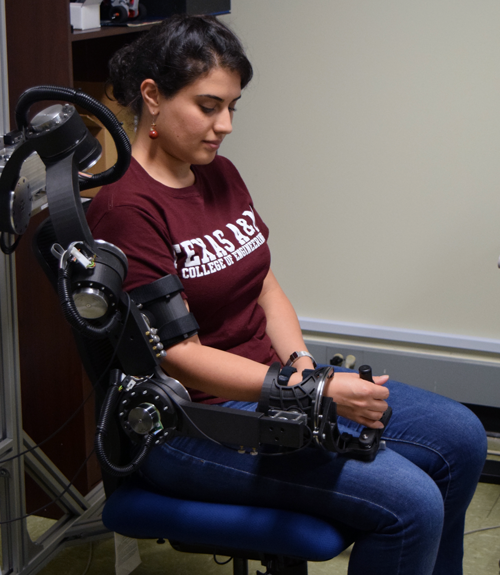Rana Soltani and her team of fellow Texas A&M University engineering students took their innovation to the next level with the Texas A&M National Science Foundation (NSF) Innovation Corps (I-Corps) Site Fellow program, constructing CLEVERarm, a mechanical exoskeleton that can act as a therapeutic aid to those with disabilities.
 CLEVERarm encases the upper limb of a patient suffering with impairments and neurological disorders, such as stroke, and provides a new and improved form of physical therapy. Previous techniques and devices used with this kind of physical therapy can be lengthy and intense, Soltani said.
CLEVERarm encases the upper limb of a patient suffering with impairments and neurological disorders, such as stroke, and provides a new and improved form of physical therapy. Previous techniques and devices used with this kind of physical therapy can be lengthy and intense, Soltani said.
“Unlike the existing devices, our developed device is a compact and lightweight full-arm robotic device, enabling easy use and transportability at different settings such as hospitals, clinics, rehabilitation gyms and even home,” Soltani said. “Due to its design novelties, it can provide a comfortable interaction experience for the user.”
The team decided to participate in order to improve their technology in several ways.
“By participating, we completed 100 customer interviews. These interviews helped us understand the rehabilitation process and users'--patients, therapists and physicians--needs better, which enabled us to improve our developed prototype to address those needs,” she said.
I-Corps didn’t just help with product development, but also the team’s comfort and presentation skills.
“In I-Corps, you get a chance to improve your presentation skills,” Soltani said. “You are forced to talk to complete strangers, and also to present your findings to your team of instructors and mentors, as well as other participants.”
Soltani said she sees a personal difference after participating.
“After I-Corps, I gave multiple presentations to large audiences and I could definitely feel the difference. I’m now totally comfortable giving a presentation to any group of any size,” Soltani said.
“Engineering graduates entering the workforce are expected to have the technical skills to address challenging problems,” Lagoudas said. “However, those who are interested to lead innovation will benefit by gaining an understanding of what it takes for an innovative design to become a successful product and create value to the company. The program allows students to gain knowledge and skills in that area and explore the different parameters impacting the success of an innovative idea.”
Soltani said she encourages other students to participate in I-Corps because it can improve the product as well as the individual’s success.
“If your innovation is still in the idea phase and you haven't developed the product, it is a great opportunity to receive feedback and better shape the idea to address the needs,” Soltani said. “Also, it is a unique opportunity to improve personal skills, which definitely helps educational and career success. I encourage any student who is thinking about I-Corps to apply.”
The College of Engineering was awarded a $500,000 NSF I- Corps Site grant to support up to 150 teams over five years. This program provides participants with the foundational elements for pursuing commercialization, access to travel funds to apply new knowledge, and gain insight for the commercial aspects of their innovation and opportunities for follow-on grants from NSF.